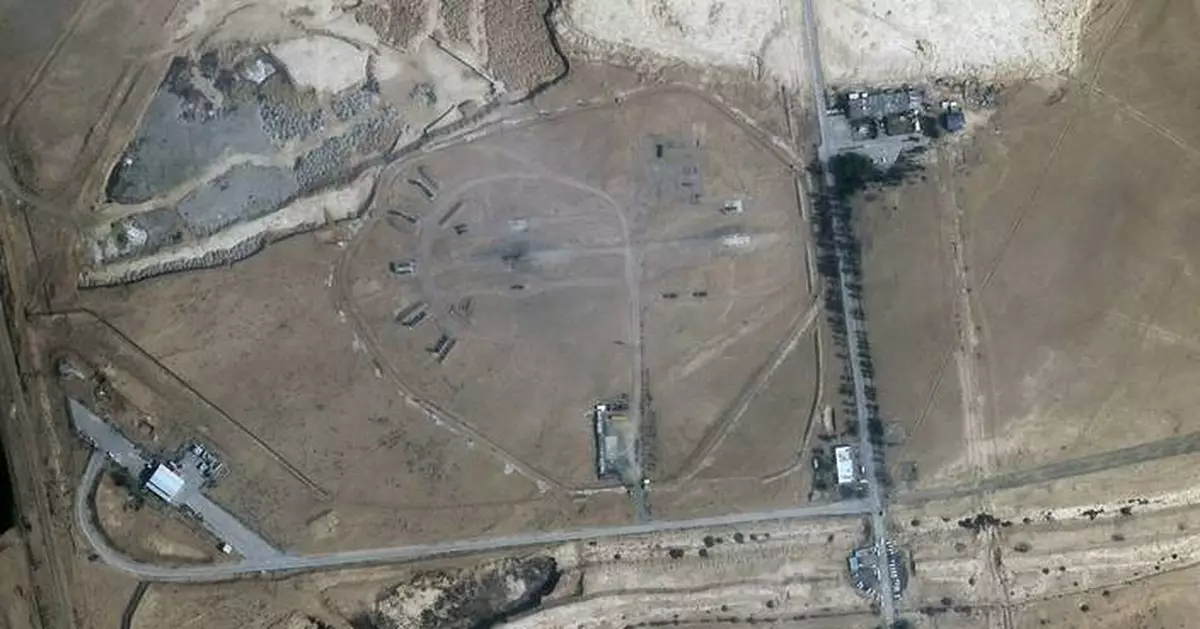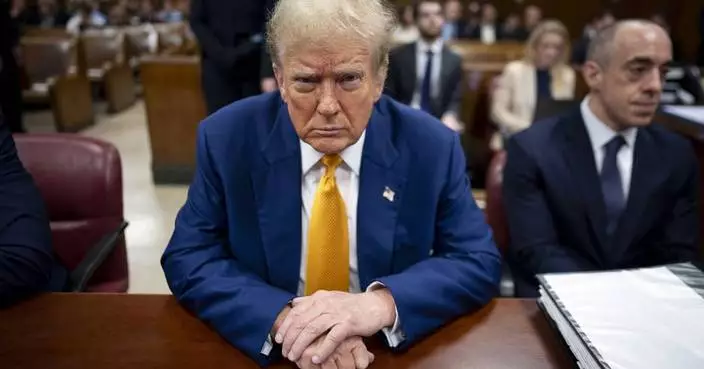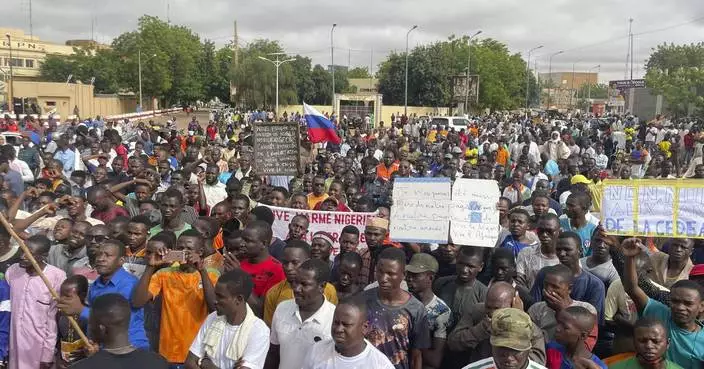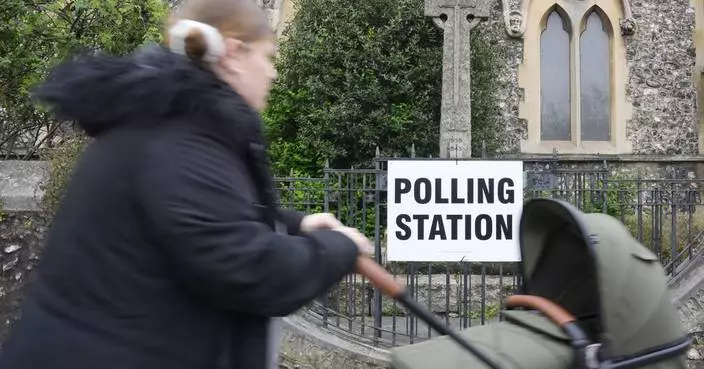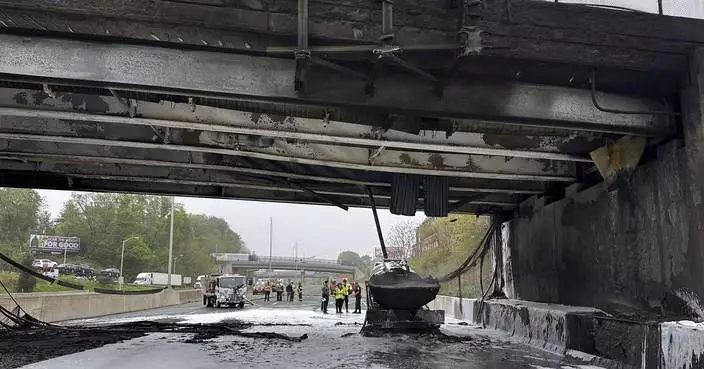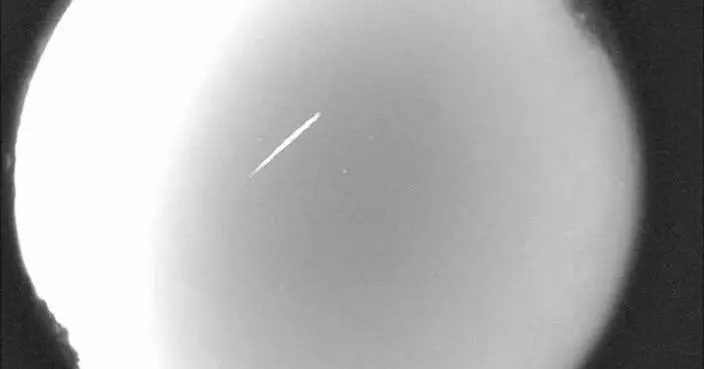JERUSALEM (AP) — Satellite photos taken Monday suggest an apparent Israeli retaliatory strike targeting Iran's central city of Isfahan hit a radar system for a Russian-made air defense battery, contradicting repeated denials by officials in Tehran of any damage in the assault.
The strike on an S-300 radar in what appears to have been a very limited strike by the Israelis would represent far more damage done than in the massive drone-and-missile attack Iran unleashed against Israel on April 13. That may be why Iranian officials up to Supreme Leader Ayatollah Ali Khamenei have been trying to dismiss discussing what the attack actually did on Iranian soil.
Analysts believe both Iran and Israel, regional archrivals locked in a shadow war for years, now are trying to dial back tensions following a series of escalatory attacks between them as the Israel-Hamas war in the Gaza Strip still rages and inflames the wider region. But a strike on the most advanced air defense system Iran possesses and uses to protect its nuclear sites sends a message, experts say.
“This strike shows Israel has the ability to penetrate Iran’s air defense systems,” said Nicole Grajewski, a fellow at the Carnegie Endowment's nuclear policy program who wrote a forthcoming book on Russia and Iran. “The precision of it was quite remarkable.”
The satellite images by Planet Labs PBC taken Monday morning near Isfahan's dual-use airport and air base, some 320 kilometers (200 miles) south of Tehran, showed an area nearby that served as a deployment point for the air defense system. Burn marks sit around what analysts including Chris Biggers, a consultant former government imagery analyst, previously had identified as a “flap-lid” radar system used for the S-300.
Less-detailed satellite images taken after Friday showed similar burn marks around the area, though it wasn't clear what was at the site. Biggers said other components of the missile system appeared to have been removed from the site before the attack — even though they provide defensive cover for Iran's underground Natanz nuclear enrichment facility.
“That’s a powerful statement, given the system, the location, and how they use it,” Biggers wrote.
On Friday, air defenses opened fire and Iran grounded commercial flights across much of the country. Officials in the aftermath sought to downplay the attack, trying to describe it as just a series of small drones flying through the sky.
“What happened ... was not a strike,” Iranian Foreign Minister Hossein Amirabdollahian claimed in an interview with NBC News. “They were more like toys that our children play with – not drones.”
In the attack's aftermath, however, Iraqis found what appeared to be remnants of surface-to-air missiles south of Baghdad. That, coupled with a suspected Israeli strike on a radar station in Syria the same day, suggests Israeli fighter jets flew over Syria into Iraq, then fired so-called “standoff missiles” into Iran for the Isfahan attack. Small, shorter-range drones may have been launched as well — Israel has been able to launch sabotage attacks and other missions inside of Iran.
Still, Iran's Foreign Ministry spokesman Nasser Kanaani repeated Tehran's denial Monday.
“Relevant authorities have announced that this harassment attack has caused no damage whatsoever and Iran’s defensive system have carried out their duties," Kanaani told journalists at a briefing. "Therefore in our opinion this issue is not worthy of addressing.”
The S-300 and their years-delayed delivery to Iran show the challenge Tehran faces in getting any foreign-made advance weapon systems into the country. Russia and Iran initially struck a $800 million deal in 2007, but Moscow suspended their delivery three years later because of strong objections from the United States and Israel.
After Iran reached its 2015 nuclear deal with world powers, Russia unfroze the deal and is believed to have given Iran four sets of an export variant of the S-300.
The relationship between Iran and Russia has deepened in recent years. Moscow relies heavily on Iran's bomb-carrying Shahed drones to target sites across Ukraine as part of its war on the country. Those same drones featured in the Islamic Republic's attack on Israel.
Tehran meanwhile has made repeated comments over recent years about trying to obtain Sukhoi Su-35 fighter jets from Russia to improve its decades-old fighter fleet. In September, a Russian-made YAK-130 combat trainer aircraft entered service in Iran. That model can be used to train pilots for the Su-35.
Russia now has the S-400, but the S-300 which has a range of up to 200 kilometers (125 miles) and the capability to track down and strike multiple targets simultaneously, remains one of the most-potent air defense weapons in the world. The batteries can be used to shoot down missiles as well as aircraft.
Iran likely needs Russian assistance to repair the damaged radar — and will seek newer weapons as well as time goes on, Grajewski said.
“Iran wants new weapons from Russia all the time – to try to show that it’s not so isolated,” she said.

FILE - A Russian-made S-300 air defense system sits on display for the annual Defense Week, marking the 37th anniversary of the 1980s Iran-Iraq war, at Baharestan Square in Tehran, Iran, Sept. 24, 2017. Satellite photos taken Monday suggest an apparent Israeli retaliatory strike targeting Iran's central city of Isfahan hit a radar system for a Russian-made air defense battery, contradicting repeated denials by officials in Tehran in the time since the assault. (AP Photo/Vahid Salemi, File)

Burn marks surround what analysts identify as a radar system for a Russian-made S-300 missile battery, center, near an international airport and air base is seen in Isfahan, Iran, Monday, April 22, 2024. Satellite photos taken Monday suggest an apparent Israeli retaliatory strike targeting Iran's central city of Isfahan hit a radar system for a Russian-made air defense battery, contradicting repeated denials by officials in Tehran in the time since the assault. (Planet Labs PBC via AP)

A missile defense site near an international airport and air base is seen in Isfahan, Iran, Monday, April 22, 2024. Satellite photos taken Monday suggest an apparent Israeli retaliatory strike targeting Iran's central city of Isfahan hit a radar system for a Russian-made air defense battery, contradicting repeated denials by officials in Tehran in the time since the assault. (Planet Labs PBC via AP)
NEW YORK (AP) — Donald Trump returned to Manhattan court on Friday as his hush money trial entered its 11th day, capping a frenzied second week of witness testimony.
Lawyer Keith Davidson concluded his testimony Thursday after spending nearly 6 1/2 hours on the stand over two days. He laid out for jurors details of his negotiations with Michael Cohen and the National Enquirer on behalf of Stormy Daniels and Karen McDougal, not shying away from an election night realization that his efforts might have contributed to Trump's 2016 win.
Forensic analyst Douglas Daus also took the stand, testifying about what he found on Cohen's cellphone. Among other things, Daus said Cohen had nearly 40,000 contacts saved to the device.
Thursday's proceedings included a contempt hearing over whether the former president had again violated his gag order.
Merchan heard from both sides about four more prospective violations, including comments Trump made about the jury. Prosecutors said they were seeking only fines and not jail time for the potential violations. An immediate decision was not made and it was unclear when Merchan would rule.
Prosecutors have said that Trump and others conducted a scheme to illegally influence the 2016 election by purchasing and burying salacious stories that might hurt his campaign.
Trump is accused of falsifying internal business records to cover up hush money payments — including $130,000 given to Daniels, a porn actor, by Cohen — recording them instead as legal expenses.
Trump has pleaded not guilty to 34 felony counts of falsifying business records.
The case is the first-ever criminal trial of a former U.S. president and the first of four prosecutions of Trump to reach a jury.
Currently:
— Donald Trump moves much of his White House campaign to New York
— Key players: Who’s who at Donald Trump’s hush money criminal trial
— The hush money case is just one of Trump’s legal cases. See the others here
— Trial begins for financial executive in insider trading case tied to taking Trump media firm public
Here's the latest:
Donald Trump has paid his $9,000 fine for violating the gag order in his hush money criminal trial.
The former president paid the penalty Thursday, ahead of a Friday deadline. Trump’s legal team supplied the court clerk’s office with two cashier’s checks — one for $2,000 and one for $7,000.
Judge Juan M. Merchan ordered Trump to pay the fine after holding him in contempt of court and finding that posts he made online about his ex-lawyer Michael Cohen, porn actor Stormy Daniels and the composition of the jury had violated the gag order.
Merchan is currently weighing a prosecution request to hold Trump in contempt again and fine him $1,000 for each of four more alleged violations from last week. Merchan has warned Trump that he could be jailed if he keeps breaching the gag order.
A government agency at the heart of Donald Trump’s separate classified documents criminal case got a name drop at his New York hush money trial on Friday.
Georiga Longstreet testified that she used the National Archives and Records Administration’s archive of the official presidential account on Twitter, now known as the social platform X, to help verify the authenticity of Trump’s account.
Longstreet noted that Trump’s official government account, @POTUS45, frequently reposted posts from Trump’s @realdonaldtrump account.
There was no visible reaction from Trump to the mention of the National Archives, whose pursuit of records he took from the White House to his Mar-a-Lago estate in Florida after his 2020 election loss led to charges alleging that he illegally hoarded classified documents.
Georgia Longstreet, a paralegal with the Manhattan district attorney's office, was called as the next witness in Donald Trump's hush money case on Friday.
She has been assigned to the Trump case for the past year and a half and her role has been to review publicly available records relevant to the case, including Trump’s social media accounts on the social platform X — formerly known as Twitter — Facebook, LinkedIn and Truth Social.
Picking up where he left off on Thursday, Trump attorney Emil Bove plied Douglas Daus, the forensic analyst, with a set of deeply technical questions Friday meant to suggest that Michael Cohen may have doctored a 2016 recording played in court the previous day.
As evidence, Bove noted that the audio cuts off suddenly, as well as “gaps” in the handling of the phone that Daus agreed were “not ideal.”
Prosecutors say the abrupt ending of the recording was the result of Cohen receiving another call. Under questioning from Bove, Daus said there was no record of an incoming call in the phone’s metadata — but said it would be difficult to say for sure without looking at call log data from Cohen’s phone carrier.
“In many ways, we’re just going to have to take Michael Cohen’s word for it, aren’t we?” Bove said.
“Yes,” Daus replied.
With that, Bove concluded his cross-examination.
Before testimony resumed in Donald Trump's hush money trial, Judge Juan M. Merchan ruled to prevent prosecutors from showing the jury a photograph of Trump with Billy Bush and soap opera actor Arianne Zucker at the time of the infamous “Access Hollywood” recording.
Trump lawyer Todd Blanche had asked for the image to be excluded from the trial, pointing to a recent court decision overturning Harvey Weinstein’s rape conviction. In that case, the appeals court ordered a retrial because the judge had allowed testimony at trial unrelated to the allegations.
Merchan said the appeals court decision “doesn’t really factor into this” case, noting that the ruling had not laid out any new law, but nevertheless agreed to block prosecutors from introducing the photograph.
Prosecutors had said the image would help establish the timeline of the revelations about the “Access Hollywood” tape, in which Trump could be heard bragging about grabbing women without permission.
Merchan has previously ruled the 2005 tape cannot be played in court for jurors, but said prosecutors can still question witnesses about the recording.
Trump lawyer Emil Bove on Friday morning resumed cross-examination questioning of Douglas Daus, a forensic analyst at the Manhattan district attorney’s office who extracted recordings, text messages and other evidence from two of Michael Cohen’s iPhones.
Judge Juan M. Merchan started the trial day also by clarifying that Donald Trump’s gag order doesn’t prohibit him from testifying on his own behalf, apparently responding to comments the former president made after court the day before.
“The order restricting extrajudicial statements does not prevent you from testifying in any way,” Merchan said, adding that the order does not in any way limit what Trump says on the witness stand.
Merchan directed his comments to Trump and his lawyers, saying it had come to his attention that there may have been a “misunderstanding” regarding the order.
Speaking to reporters before heading into court on Friday, Donald Trump clarified comments he made the day before about his gag order, saying it does not stop him from testifying in the case but it does keep him from “talking about people and responding when they say things about me.”
After court adjourned on Thursday, Trump had responded to questions about what he’d thought of the day’s testimony.
“I’m not allowed to testify. I’m under a gag order,” he said, causing some confusion. The gag order bars him from making public statements about witnesses, jurors and some others connected to the case.
He also commented on the latest job numbers showing that U.S. employers scaled back hiring in April and said they’re “horrible.”
Donald Trump has arrived at the courthouse in Manhattan for the 11th day of his hush money trial.
Hope Hicks, who served as Donald Trump's 2016 campaign press secretary and went on to hold various roles in his White House, could testify in his hush money trial as early as Friday.
The two people who described her forthcoming appearance to The Associated Press insisted on anonymity to discuss internal trial preparations.
Hicks spoke with Trump by phone during a frenzied effort to keep his alleged affairs out of the press in the final weeks before the election.
Associated Press writers Eric Tucker in Washington and Jake Offenhartz in New York contributed to this report.
Despite not yet having testified in Donald Trump's hush money case, Michael Cohen has been very present in the courtroom — in audio recordings of conversations he had and in witness testimony.
On Thursday, jurors heard a taped call between Cohen and Keith Davidson, Stormy Daniels' former attorney, wherein Cohen could be heard telling Davidson about a conversation he'd had with someone believed to be Trump.
“I can’t even tell you how many times he said to me, ‘You know, I hate the fact that we did it.’ And my comment to him was, ‘But every person that you’ve spoken to told you it was the right move,’” Cohen said in the recording.
The panel also heard a recording of Cohen briefing Trump in September 2016 on the plan to buy former Playboy model Karen McDougal’s story. That particular recording included Cohen detailing that he'd spoken to then-Trump Organization Chief Financial Officer Allen Weisselberg about “how to set the whole thing up with funding.”
Cohen, who is the prosecution's star witness, was Trump's lawyer and personal fixer at the time.
Court proceedings in Donald Trump's hush money case will end early on Friday to accommodate an important appointment one of the jurors has in the late afternoon.
Judge Juan M. Merchan announced the scheduling change just before adjourning court on Thursday. Court will end at 3:45 p.m. Friday, about 45 minutes earlier than normal.
Donald Trump is expected to return to court Friday morning for the 11th day of his hush money trial as the second week of witness testimony wraps up.
Thursday's proceedings saw the former president facing yet another contempt hearing, this time over four more prospective violations of his gag order.
While Judge Juan M. Merchan did not immediately rule on the sanctions request from prosecutors, he told defense attorneys he was concerned about three of the potential violations — including comments that Trump made about the political makeup of the jury. Merchan said he wasn't worried about a comment Trump made last week calling former Enquirer publisher David Pecker a “nice guy.”
Prosecutors said they were only seeking fines and not jail time over the potential violations.
Trump is barred under a gag order from speaking publicly about witnesses, jurors and some others connected to the case. He was fined $9,000 on Tuesday over nine online posts.
The introduction has been updated to correct the spelling of the last name of forensic analyst Douglas Daus, from Daul.

Former President Donald Trump arrives at Manhattan criminal court in New York, on Friday, May 3, 2024. (Doug Mills/The New York Times via AP, Pool)

Former President Donald Trump appears at Manhattan criminal court before his trial in New York, Friday,, May 3, 2024. (Doug Mills/The New York Times via AP, Pool)

Former President Donald Trump appears at Manhattan criminal court before his trial in New York, Friday,, May 3, 2024. (Jeenah Moon/Pool Photo via AP)

Former President Donald Trump appears at Manhattan criminal court before his trial in New York, Friday,, May 3, 2024. (Jeenah Moon/Pool Photo via AP)

Former President Donald Trump arrives at Manhattan criminal court before his trial in New York, Thursday, May 2, 2024. (Charly Triballeau/Pool Photo via AP)

Former President Donald Trump sits inside Manhattan Criminal Court, Thursday, May 2 2024. (Mark Peterson/Pool Photo via AP)

Former President Donald Trump arrives at Manhattan criminal court before his trial in New York, Thursday, May 2, 2024. (Charly Triballeau/Pool Photo via AP)





